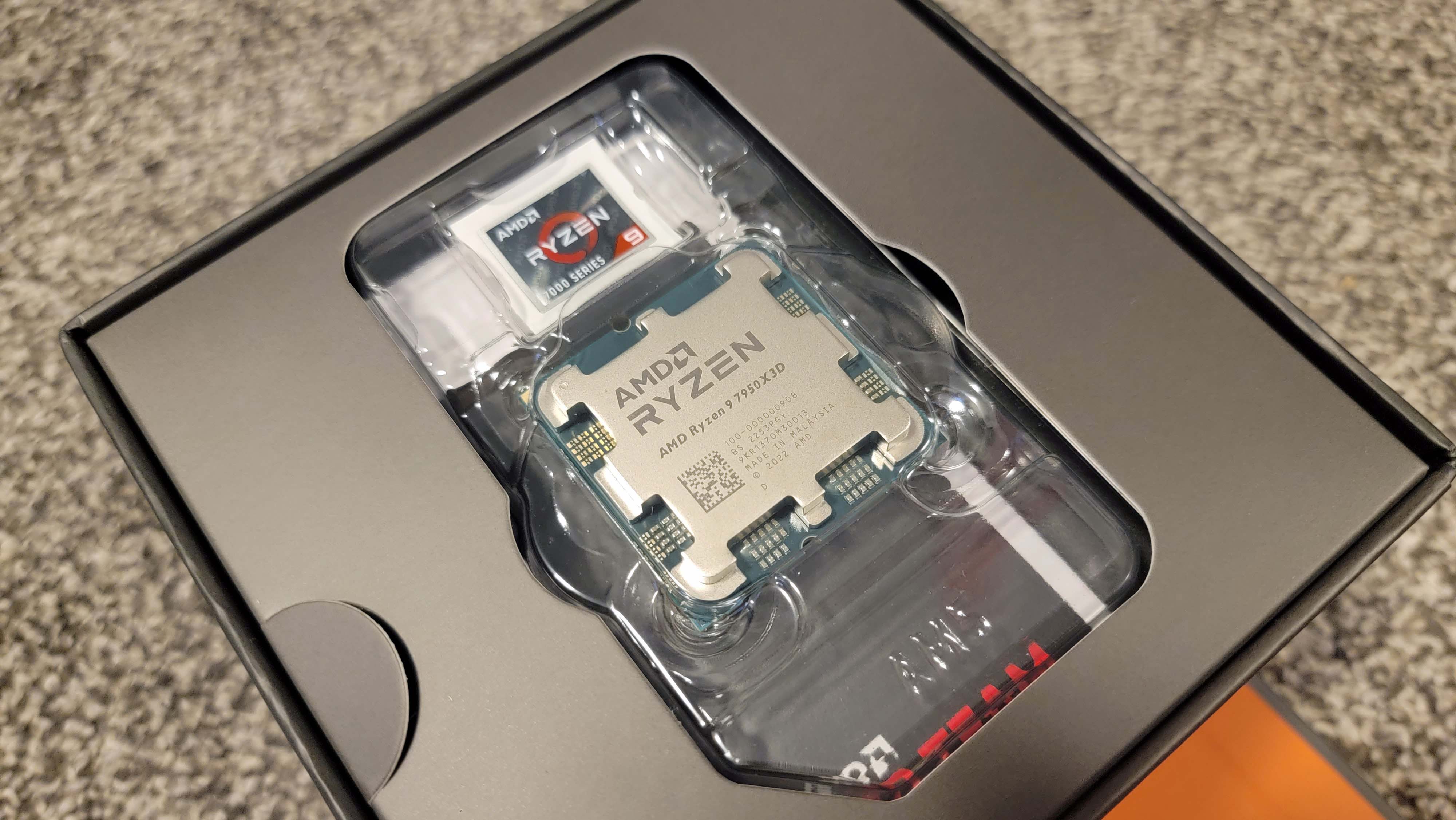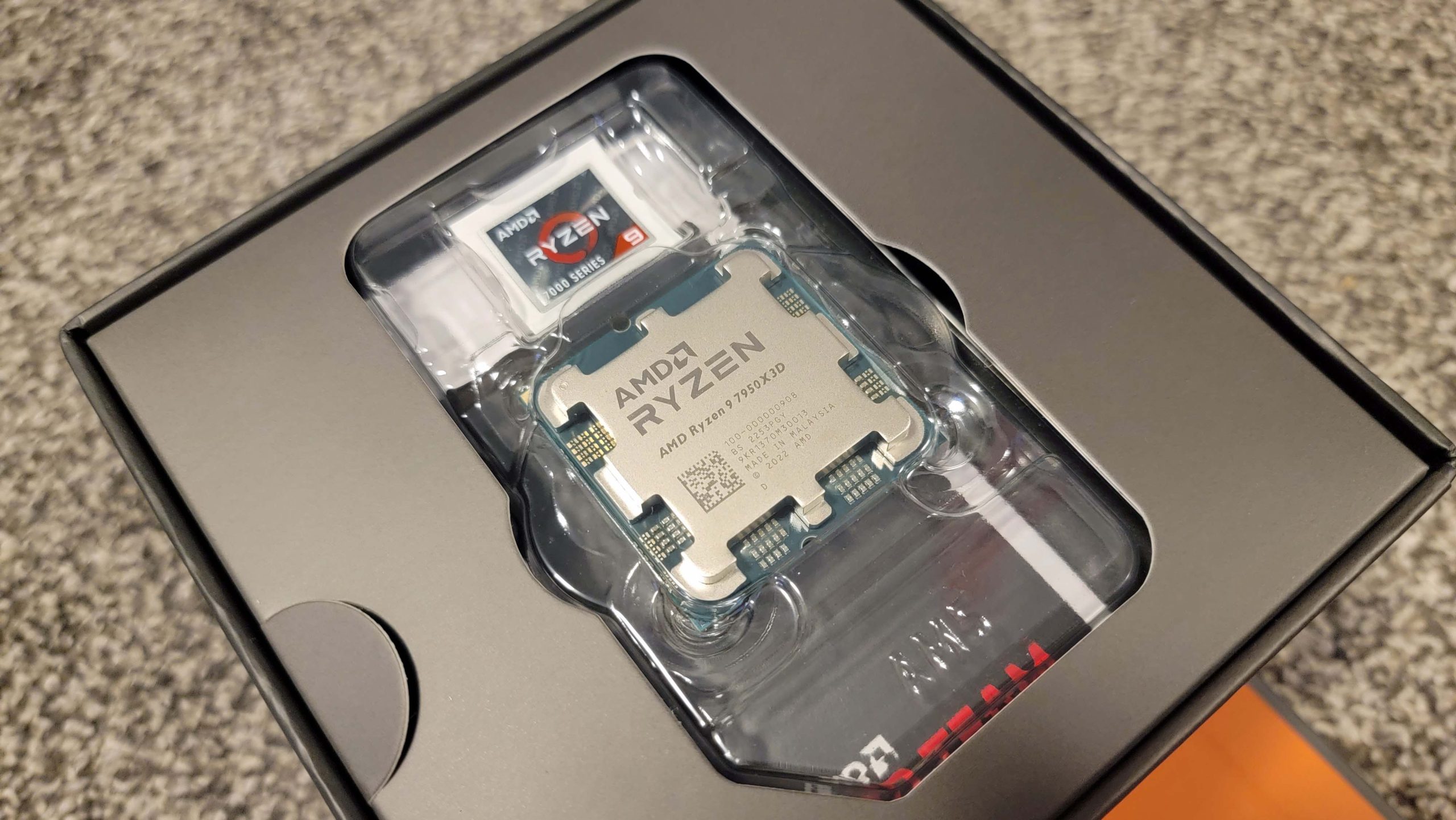
AMD Ryzen 9 7950X3D Review: AMD Retakes Gaming Crown with 3D V-Cache
AMD’s $699 Ryzen 9 7950X3D is geared specifically for gamers looking to blast through CPU-limited games while still having the threaded heft of 16 cores that can handle the heaviest of productivity workloads. The new chip comes packing sixteen Zen 4 cores and the company’s second-gen 3D V-Cache tech that unlocks 128MB of L3 cache, a combo that delivers the fastest gaming performance available on the market. In our tests, the 7950X3D beats Intel’s fastest chip, the 6 GHz Core i9-13900KS, by 13% on average and up to 40%+ in some games, taking the top spot on our list of the best CPUs for gaming.
The 7950X3D uses AMD’s cutting-edge 3D chip-stacking technology, called 3D V-Cache, to enable an incredible 128MB of L3 cache. Like AMD’s inaugural X3D chip, the Zen 3 Ryzen 7 5800X3D, the extra L3 cache comes courtesy of a 3D-stacked SRAM chiplet fused atop the processor with hybrid bonding, which accelerates gaming to new heights in many titles. AMD also has a new thread-targeting technique designed to help apply the gains more evenly across a broad range of games.
The first-gen 3D V-Cache chip gave AMD a lead over Intel’s competing processors, cementing it as the go-to chip for gamers, but it suffered in some productivity apps due to a limit of eight cores and its relatively low boost frequency. AMD’s new 16-core Ryzen 9 7950X3D is the first 3D V-Cache chip to employ two compute chiplets, boosting productivity apps and enabling a higher boost frequency of 5.7 GHz, a big improvement over the previous-gen’s 4.5 GHz peak.
| Price | Cores / Threads (P+E) | P-Core Base / Boost Clock (GHz) | Cache (L2/L3) | TDP / PBP / MTP | |
|---|---|---|---|---|---|
| Ryzen 9 7950X3D | $699 | 16 / 32 | 4.2 / 5.7 | 144MB (16+128) | 120W / 162W |
| Ryzen 9 7900X3D | $599 | 12 / 24 | 4.4 / 5.6 | 140MB (12+132) | 120W / 162W |
| Ryzen 7 7800X3D | $449 | 8 /16 | 4.2 / 5.0 | 104MB (8+96) | 120W / 162W |
| Ryzen 7 5800X3D | $348 | 8 /16 | 3.4 / 4.5 | 104MB (8+96) | 105W |
Intel’s Raptor Lake recently took the gaming performance crown from AMD’s Zen 4 Ryzen 7000 chips, but AMD has now broadened its X3D attack with three chips that come in 8-, 12- and 16-core flavors spanning from the $449 to $699, all of which come with the company’s newest Zen 4 architecture etched on the 5nm process. These chips drop into AM5 motherboards that support the latest connectivity tech, like DDR5 and PCIe 5.0, addressing another shortcoming of the first-gen model. AMD has also unlocked the chip for basic overclocking and undervolting.
The 7950X3D is the highest-end model, but we haven’t tested the 12-core $599 Ryzen 9 7900X3D that also comes to market tomorrow — AMD doesn’t plan to sample that chip to press. However, if history is any indication, the 7900X3D should deliver nearly identical gaming performance to the pricier 7950X3D. The $449 eight-core Ryzen 7 7800X3D arrives later in April, and that will undoubtedly be the chip to beat: AMD tells us it will offer the lion’s share of 3D V-Cache’s gaming performance, but it comes at a much more affordable price point.
There are some tradeoffs, though — some games don’t benefit from the 3D V-Cache, and the chip isn’t as fast in productivity apps as competing Intel chips. The 7950X3D also suffers from many of the pain points we’ve already seen with the fledgling AM5 platform — the motherboard ecosystem is more expensive than Intel’s offerings, and the strict requirement for DDR5 significantly increases costs compared to Intel’s DDR4-friendly platform.
Of course, price isn’t as much of a consideration for the highest-end gaming systems like one you would build around the 7950X3D, and the chip draws far less power than Intel’s Raptor Lake. That means you’ll have a cooler and quieter machine that also happens to have the fastest gaming processor money can buy, all while doing well in other CPU benchmarks. Intel doesn’t have a comparable tech to boost L3 cache capacity, so the 7950X3D will hold the gaming title for this generation of processors. We also dug up some new details on AMD’s second-gen 3D V-Cache tech. Let’s take a closer look.
AMD Ryzen 9 7950X3D Pricing and Specifications
| Street/MSRP | Cores / Threads (P+E) | P-Core Base / Boost Clock (GHz) | E-Core Base / Boost Clock (GHz) | Cache (L2/L3) | TDP / PBP / MTP | Memory | |
|---|---|---|---|---|---|---|---|
| Ryzen 9 7950X3D | $699 | 16 / 32 | 4.2 / 5.7 | 144MB (16+128) | 120W / 162W | DDR5-5200 | |
| Core i9-13900KS | $699 | 24 / 32 (8+16) | 3.0 / 6.0 | 2.2 / 4.3 | 68MB (32+36) | 150W / 253W / 320W | DDR4-3200 / DDR5-5600 |
| Core i9-13900K / KF | $589 (K) – $564 (KF) | 24 / 32 (8+16) | 3.0 / 5.8 | 2.2 / 4.3 | 68MB (32+36) | 125W / 253W | DDR4-3200 / DDR5-5600 |
| Ryzen 9 7950X | $579 ($699) | 16 / 32 | 4.5 / 5.7 | – | 80MB (16+64) | 170W / 230W | DDR5-5200 |
| Ryzen 9 7900X3D | $599 | 12 / 24 | 4.4 / 5.6 | 140MB (12+132) | 120W / 162W | DDR5-5200 | |
| Ryzen 9 7900X | $419 ($549) | 12 / 24 | 4.7 / 5.6 | – | 76MB (12+64) | 170W / 230W | DDR5-5200 |
| Core i7-13700K / KF | $409 (K) – $384 (KF) | 16 / 24 (8+8) | 3.4 / 5.4 | 2.5 / 4.2 | 54MB (24+30) | 125W / 253W | DDR4-3200 / DDR5-5600 |
| Ryzen 7 7800X3D | $449 | 8 /16 | 4.2 / 5.0 | 104MB (8+96) | 120W / 162W | DDR5-5200 | |
| Ryzen 7 5800X3D | $348 ($449) | 8 /16 | 3.4 / 4.5 | 104MB (8+96) | 105W | DDR4-3200 | |
| Ryzen 7 7700X | $349 ($399) | 8 /16 | 4.5 / 5.4 | – | 40MB (8+32) | 105W / 142W | DDR5-5200 |
The Ryzen 9 7950X3D has 16 cores and 32 threads and only works on AM5 platforms. On the surface, the 7950X3D appears to merely be a Ryzen 9 7950X with an extra L3 cache chiplet and additional silicon and software tuning. As before, the 3D-stacked SRAM L3 chip weighs in at 64MB, so the 7950X3D comes with a beastly 144MB of total cache, with 128MB of that being gaming-boosting L3 cache.
Even though they come with 8, 12, and 16 cores, AMD’s Zen 4 3D V-Cache processors all have a base TPD of 120W and a max 162W PPT. That means the 7950X3D’s ratings are 68W lower than the 170W/230W rating for the standard 7950X, which will have an impact on heavy work. The reductions aren’t entirely surprising, as the additional cache chiplet can result in slightly higher operating temperatures. In fact, the 7950X3D’s maximum supported temperature is 89C, which is lower than the 7950X’s limit of 95C and the previous gen 5800X3D’s 90C limit.
AMD has significantly increased the boost speeds with the new X3D models — the 7950X3D boosts to 5.7 GHz, a big leap over the previous gen 5800X3D’s peak of 4.5 GHz, and the same as the standard 7950X. The base clock declines 200 MHz compared to the 7950X, a necessary accommodation for the lower power envelope. The chip doesn’t come with a bundled cooler — AMD recommends a 280mm water cooler, or better, for the Ryzen 7000X3D processors.
AMD only allowed overclocking the memory and Infinity Fabric for the previous-gen 5800X3D but will now also allow both the auto-overclocking Precision Boost Overdrive (PBO) and Curve Optimizer. AMD still doesn’t allow direct frequency overclocking due to a voltage limitation for one of the chiplets.
The $599 12-core 24-thread Ryzen 9 7900X3D peaks at 5.6 GHz, the same as the standard 7900X, while base clocks decline a relatively minor 300 MHz. This chip comes armed with 104MB of cache, with 96 MB carved out as L3.
The $449 Ryzen 7 7800X3D is a single-CCD chip that’s comparable to the first-gen Ryzen 7 5800X3D, but it comes with a much faster Zen 4 architecture. The 8-core 16-thread 7800X3D has 96MB of L3 cache, the same core count and cache capacity as its Zen 3 predecessor. The 7800X3D has a 4.2 GHz base clock and a 5.0 GHz boost, both of which are higher than the 5800X3D’s 3.4 GHz base and 4.5 GHz boost.

Both the 7950X3D and the 7900X3D have two eight-core Core Compute Die (CCD) chiplets, marking the first time AMD has brought the 3D V-Cache tech to a multi-CCD processor. The above image shows that AMD only mounts a single 7nm SRAM chiplet atop one eight-core CCD, leaving the other CCD bare.
This allows the chiplet without the 3D-stacked SRAM to operate at full speed, thus delivering the high boost clocks we see on the spec sheet for applications that prize frequency. Meanwhile, the SRAM-stacked CCD will operate at a slightly lower clock rate than the rated boost for the chip but satisfy the needs of applications that prize low-latency access, like games. The chip itself has a peak of 1.4V, enabling the high boost clocks, but the 3D V-Cache-equipped CCD has a ~1.1V limit to keep thermals in check.
Only fusing the SRAM onto one CCD also reduces manufacturing costs, as the hybrid bonding process and additional chiplet make this an expensive technology. AMD also says that using two V-Cache chiplets doesn’t provide enough performance uplift to justify the extra costs.
In either case, the new design requires the combination of a new chipset driver and Windows Xbox Game Bar to place threads for different types of workloads on the correct chiplet. Unfortunately, AMD didn’t share many details about the new second-gen 3D V-Cache’s hardware implementation, but we recently found plenty of new details at a recent tech conference. We have the details of AMD’s thread targeting implementation and the second-gen 3D V-Cache hardware on the following pages; then, it’s on to the gaming benchmarks.
- MORE: Best CPU for gaming
- MORE: CPU Benchmark Hierarchy
- MORE: Intel vs AMD
- MORE: How to Overclock a CPU

